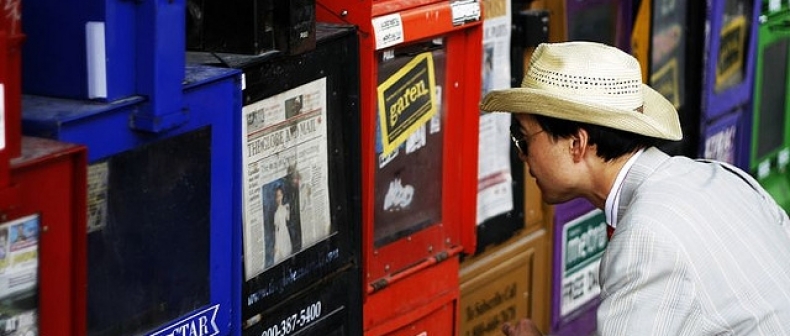
Image via flickr user christopher.woo
The National Post and Toronto Star announcing they will join the Globe and Mail by putting their online content behind a paywall marks a significant shift in the world of Canadian media. The papers have every right to charge people for their content — they are running a business after all – but the backlash they face is of their own making having offered the news for free for all these years. With that in mind, is a rigid monthly subscription the best way to keep their business afloat? My instinct tells me that the revenue gained from subscribers may not be enough to make up for the lost readership that will be turned away by the paywall. The good news is I think there is a happy media medium.
I offer these ideas free of charge, but feel free to hire me as a consultant. My rates are reasonable.
Offer a pay-as-you-go option
Whether it’s $20 a month or $10 or even $5, by putting up an all-or-nothing paywall, news outlets are going to lose casual readers to free services. Some may be willing to pay the subscription fee for unlimited access because they read every piece of news a certain paper publishes, but what if I want to read 15 articles a month? I get my 10 free articles for free but then the Globe loses five page views from me because I’m not willing to fork over $20 per month for those extra five stories. Eventually I’ll get hooked on free news from somewhere else. (Details haven’t been announced yet but Postmedia’s paywalls will be “metered,” suggesting they will offer a usage based fee. The Star will announce details “in the coming months.”)
Some people have suggested The Post, Globe and Star should offer a bundle package for access to all three papers. The idea of bundling multiple services to save money is fine, but who is going to administer those bundled subscriptions? The three newspapers would have to come to some sort of revenue sharing model creating an additional layer of middlemen, driving up the cost of delivering the service. Good luck getting these competitors to play nice.
Look at the television industry: The most common complaint about cable subscriptions, after the overall high cost, is probably that subscribers are forced to pay for channels they don’t want because they are bundled together with the ones they do. But thanks to recent CRTC decision, broadcasting seems to be shifting to a more “a la carte” model and newspapers would be wise to follow suit and let readers pick and choose what they pay for.
The success of independent producers connecting directly with consumers, like Louis CK’s company selling downloads of CK’s stand-up specials directly off his website, suggests that media consumers are willing to pay for digital content so long as there is a certain guarantee of quality from a trusted source. But the key takeaway from CK’s successful experiment should be that his model is flexible. Five dollars gets you restriction-free access to the special — you can download it and keep it forever and do whatever you want with it. But you aren’t locked into buying any more of his content if you don’t want to. I may want to read an exclusive Globe and Mail profile of the Prime Minister, but I’ll feel cheated if I feel like I’m subsidizing their not-interesting-to-me Life section. Regardless of how those funds are actually allocated, let me feel like I’m paying for what I’m getting and you’ll get my click. I’ll go out with the Globe but I don’t want to be married to it.
Embrace micropayments
Charge a tiny fee for each article, somewhere in the range of one to ten cents, maybe a dollar for big features and special reports. It’s less daunting than a lump sum each month for casual readers who will question whether a subscription is worth it.
It will create healthy competition between the dailies as they fight to write the most compelling headlines to attract the most clicks. It’ll be just like “the good ‘ol days” when newsies shouted headlines on street corners to sell papers. Fears about link-baiting — that outlets will write outrageous headlines for silly stories to get your money – will prove immaterial because at the end of the day, it will be no different from today’s tabloids. Some people will click and pay to read sensational news just as people today grab magazines with salacious headlines at the grocery check out. More discerning readers will learn to click judiciously if they know they’ll be charged a tiny fee to read on. Being addicted to free news is like being addicted to free plastic bags. Even a tiny fee will make us think twice about what we’re choosing to read. At the very least it should put an end to Gangnam Style stories on the front page of TheStar.com.
It’s important to note that we shouldn’t tie individual journalists’ pay to how much money a single story generates. Like in any industry, when someone does well and creates value for their employer, an individual should be rewarded with considerations for pay raises and promotions, but to tie someone’s salary directly to a percentage of gross income would undoubtedly lower the quality of the journalism produced as journalists would be pitted against one another in a bar-lowering competition for page views. That bar should be raised or lowered by the editorial board. Although, tying salary to the success of an article would be an interesting possibility for superstar commentators, not unlike the contracts of A-List movie stars.
Change how online news is shaped
What happens if I follow a tweet that says, “Rob Ford arrested at gunpoint” (or whatever) only to discover I just paid for a two sentence long article that ends with “more details to come?” Do I have to pay again when I read the updated article to find out what happened? In the fast-paced publish-now-fact-check-later Internet age, another interesting idea would be to charge by the story, not the article. The thing that users are actually paying for could look more like a live-blog feed as opposed to a traditional static Internet article. As a story breaks and more information comes out, a reader’s feed would be updated but they would only have to pay once. If a story gets so big that extra analysis from columnists is warranted or things like infographics are created to illuminate and provide context to the events, those premium elements could be unlocked with another payment, but the initial newsfeed would be covered by a single payment. Use the Internet to it’s full potential and design the best looking news experience. Similar to the Globe’s PR campaign, The Star’s message from Publisher John Cruickshank about the coming changes notes that “new and innovative features on thestar.com, designed to provide a rich, multimedia experience” will accompany the subscription fee, so we shall soon see what these guys have up their sleeves.
Offer some new services and lose some old ones
A big reason newspapers lost money with the dawn of the Internet was not only because people were now able to get their news for free, but newspapers lost revenue from paid classifieds to free sites like craigslist. Instead of focusing on how to charge more for stuff people are used to getting, come up with new services for your readers that you are uniquely positioned to deliver to them. Create trade journal mini-sites with subscription fees that target specific industries; run seminars and lectures led by your talent and charge admission; innovate something I can’t think of.
Perhaps most importantly, newspapers must not be afraid to drop coverage and features that fall outside their area of expertise. Newspapers need to ask themselves if they need to be reviewing Hollywood movies if there is no local connection. There are still readers who get their movie news from local outlets, but future generations of media users are going to go to film focused outlets, especially if they are free. Arts and culture need coverage (not to mention sports, health, and other sections) but general interest newspapers will need to focus on their territory while more nimble specialized outlets go in-depth. Every media outlet big and small will have to concede that they cannot afford to commit resources to things they don’t do as well as others. Unfortunately, that may mean downsizing to remain profitable.
In short, innovation, flexibile payment options and editorial restraint will be key to success. Also, stop printing those terrible comics and save money on expensive colour ink. Oh, and don’t plagiarize anbody.
____
Michael Kolberg is The Sprawl Editor at Toronto Standard. Follow him on Twitter for jokes @mikeykolberg
For more, follow us on Twitter at @torontostandard and subscribe to our Newsletter














